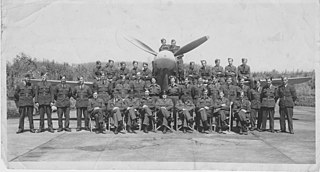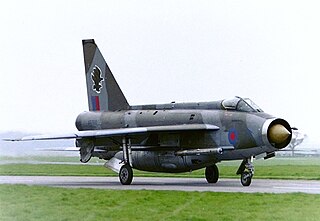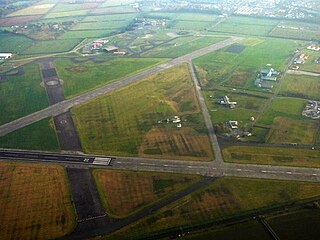
Royal Air Force Abingdon, or more simply RAF Abingdon, is a former Royal Air Force station near Abingdon, Oxfordshire. It is now known as Dalton Barracks and is used by the Royal Logistic Corps.
Royal Air Force Long Kesh, or more simply RAF Long Kesh, is a former Royal Air Force station at Maze, Lisburn, Northern Ireland.

Royal Air Force Ballyhalbert or more simply RAF Ballyhalbert is a former Royal Air Force station at Ballyhalbert on the Ards Peninsula, County Down, Northern Ireland

Royal Air Force Prestwick or simply known as RAF Prestwick, is a former Royal Air Force station based at the NATS air traffic control centre, adjacent to Glasgow Prestwick Airport, South Ayrshire, in south west Scotland. The unit was home to the Scottish Air Traffic Control Centre (Military) which provided an air traffic control service to military aircraft operating within its area of responsibility. Prestwick was also home to a Distress and Diversion (D&D) Cell which provided assistance to both military and civil aircraft in an emergency.

Tain Air Weapons Range is a Ministry of Defence air weapons range on the Dornoch Firth near Tain in Scotland. Royal Air Force aircrews from RAF Lossiemouth are trained in air weaponry on the range, along with NATO aircrew.
Royal Air Force Bircham Newton or more simply RAF Bircham Newton is a former Royal Air Force station located 2.1 miles (3.4 km) south east of Docking, Norfolk and 13.4 miles (21.6 km) north east of King's Lynn, Norfolk, England.
Royal Air Force Heathfield, or more commonly RAF Heathfield, sometimes known as RAF Ayr/Heathfield due to its proximity to Glasgow Prestwick Airport, which was also used by military flights, is a former Royal Air Force station. It opened in April 1941 as an airbase for day and night fighter squadrons. In September 1944 it transferred to Fleet Air Arm control and commissioned as HMS Wagtail. The Royal Navy paid off the airbase in March 1946 and it was reduced to care and maintenance. The United States Air Force used it for storage between 1951 and 1957, with the designation USAAF Station 570.
HMS Fieldfare also known as R.A.F. Landing Ground Novar, then RNAS Evanton and later as RAF Evanton, is a disused airfield in Ross and Cromarty, Scotland. It lies on the shore of the Cromarty Firth near the village of Evanton. In the 1934 edition of the loose-leaf publication 'The Air Pilot' published by The Air Ministry the field is designated as 'R.A.F. Landing Ground (Seasonal) Novar'. The name Novar was later changed to Evanton.

Royal Air Force Detling, or more simply RAF Detling, is a former Royal Air Force station situated 600 feet (180 m) above sea level, located near Detling, a village about 4 miles (6.4 km) miles north-east of Maidstone, Kent.
Royal Air Force Bramcote, or more simply RAF Bramcote, is a former Royal Air Force station located 3.5 miles (5.6 km) south-east of Nuneaton, Warwickshire, England used during the Second World War. It was later transferred to the Admiralty and was known as Royal Naval Air Station Bramcote,, and when commissioned became HMS Gamecock. When it subsequently transferred to the British Army from the Admiralty, it was called Gamecock Barracks.
No. 516 Squadron RAF was an army co-operation squadron of the Royal Air Force during the Second World War.

Royal Air Force Binbrook or RAF Binbrook is a former Royal Air Force station located near Binbrook, Lincolnshire, England. The old domestic site has been renamed to become the village of Brookenby. RAF Binbrook was primarily used by Bomber Command in the Second World War. The Central Fighter Establishment moved to Binbrook from RAF West Raynham between 1959 and 1962 and two English Electric Lightning squadrons were stationed there between 1965 and 1988.

Royal Air Force Cranage or more simply RAF Cranage is a former Royal Air Force Satellite station operated during the Second World War. It was located just to the North of Middlewich, Cheshire, England.

RAF Caistor is a former Royal Air Force Relief Landing Ground located 6.2 miles (10.0 km) south east of Brigg, Lincolnshire and 9.1 miles (14.6 km) north west of Binbrook, Lincolnshire, England, the site is now used for farming.

Breighton Aerodrome is a private aerodrome primarily used for general aviation flying located on the former Royal Air Force Breighton or more simply RAF Breighton, a former Royal Air Force station located near to the village of Breighton, East Riding of Yorkshire, England.

Royal Air Force Ballykelly, or more simply RAF Ballykelly, is a former Royal Air Force station which opened in 1941 in Ballykelly, County Londonderry. It closed in 1971 when the site was handed over to the British Army as Shackleton Barracks. A small part of the base has been used as a refuelling point by army helicopters and small fixed-wing aircraft usually operating out of Joint Helicopter Command Flying Station Aldergrove near the town of Antrim.
RAF Appledram is a former Royal Air Force Advanced Landing Ground 2.3 miles (3.7 km) southwest of Chichester, West Sussex and 12.2 miles (19.6 km) east of Portsmouth, Hampshire.
Royal Air Force Fraserburgh, or more simply RAF Fraserburgh, is a former Royal Air Force satellite station located in Aberdeenshire, Scotland, 3.2 miles (5.1 km) south east of Fraserburgh and 12.3 miles (19.8 km) north west of Peterhead.
Royal Air Force Macmerry or more simply RAF Macmerry is a former Royal Air Force satellite station located 4.5 miles (7.2 km) west of Haddington, East Lothian, Scotland and 11.4 miles (18.3 km) east of Edinburgh. It was situated immediately to the north east of Macmerry on the north side of the A1 road. It has also been called RNAS Macmerry and unofficially RAF Tranent and RAF Penston during its life.

Royal Air Force Church Fenton or RAF Church Fenton is a former Royal Air Force (RAF) station located 4.3 miles (6.9 km) south-east of Tadcaster, North Yorkshire, England and 6.3 miles (10.1 km) north-west of Selby, North Yorkshire, near the village of Church Fenton.











